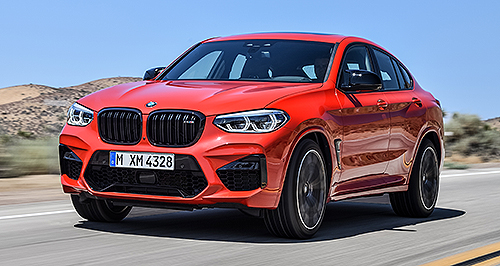Future models - BMW - X3 - MBMW unleashes bahn-storming X3 M, X4 M duoUp to 375kW on tap from new 3.0-litre six-cylinder engine in first BMW X3 M, X4 M13 Feb 2019 BMW has revealed its first pair of full-fat performance mid-size SUVs, with the X3 M wagon and X4 M coupe debuting BMW M’s new-generation 3.0-litre twin-turbocharged inline six-cylinder petrol engine.
Expected to charge into Australian showrooms in the second half of this year, the X3 M and X4 M are available in regular and Competition guises, with the former producing 353kW at 6250rpm and 600Nm from 2600 to 5600rpm, while the latter ups the power ante to 375kW and extends the peak torque band to 5950rpm.
Given local new-vehicle buyers’ penchant for higher-output models, it is expected that BMW Group Australia will exclusively launch the X3 M and X4 M in Competition form, which would mirror its approach with the M2 sportscar and M5 large sedan.
Either way, bahn-storming straight-line performance is guaranteed, with the regular models able to sprint from standstill to 100km/h in 4.2 seconds, while the Competition variants are just 0.1s quicker to triple digits.
Top speed for either grade is electronically limited to 250km/h, but the optional M Driver’s Package lifts terminal velocity to 280km/h for the regular models and 285km/h for the Competition variants.
Comparatively, Mercedes-AMG’s rivalling GLC63 S wagon ($165,395 plus on-road costs) and coupe ($172,400) are motivated by a 375kW/700Nm 4.0-litre V8 that blitzes the zero-to-100km/h run in 3.8s but only tops out at 270km/h.
Compared to BMW M’s previous-generation twin-turbo straight six that maxed out at 368kW/600Nm in the M4 GTS, the 1970kg X3 M and X4 M’s unit features revisions to the turbochargers, cylinder-head cores, high-precision fuel injection, air intake and oil supply systems, crankshaft and wastegate, while two petrol particulate filters and four catalytic converters have been added.
A dual-brand exhaust system features electronically controlled flaps that changes the X3 M and X4 M’s soundtrack from whisper quiet to booming via four modes, while BMW M’s signature quad tailpipes are again present, this time measuring 100mm in diameter each.
The seven-speed dual-clutch automatic transmission mated to the former engine in the M2 and M4 has been ditched in the X3 M and X4 M for an eight-speed torque-converter unit with paddle-shifters.
The transmission’s manual mode supports multiple downshifts to the lowest gear possible and does not force an upshift when the engine’s 7200rpm redline is hit when accelerating.
Three modes progressively increase the speed of these gear changes and move the shift points to higher engine speeds.
The X3 M and X4 M borrow their rear-biased M xDrive all-wheel-drive system from the aforementioned M5, combined with an Active M Differential that allows the driver to adjust the Dynamic Stability Control (DSC) system to the more tail-happy M Dynamic Mode – or to switch it off altogether.
Several changes have been made to the X3 M and X4 M’s chassis to improve handling, such as the inclusion of three-mode adaptive dampers for their bespoke MacPherson-strut front and multi-link rear suspension.
The electric power steering in the X3 M and X4 M is speed-sensitive like that of their base models but adds a variable ratio and gradually increases its weight and feedback via three modes.
Stopping power is handled by 395mm front and 370mm rear vented disc brakes clamped by blue-painted four-piston fixed and single-pot floating callipers respectively.
The regular models roll on Grey Orbit 20-inch alloy wheels wrapped in a mixed set of tyres (front: 255/45, rear: 265/45), while the Competition variants instead feature Jet Black 21-inch rims shod in 255/40 front and 265/40 rear rubber.
As for the rest of the X3 M and X4 M’s exterior design, it features several of BMW M’s signature elements, including the black double-bar kidney grille, large front air intakes, aerodynamic side mirrors and gills, and diffuser plus a rear spoiler.
Inside, a BMW M-specific digital instrument cluster, windshield-projected head-up display, front sports seats, sports steering wheel and gear selector feature.
Claimed fuel consumption on the combined cycle test is 10.5 litres per 100 kilometres for the X3 M, while the X4 M is 0.1L/100km thirstier. Carbon dioxide emissions for the pair are 239 grams per kilometre.  Read moreAll future models Alfa Romeo Alfa Romeo Abarth Abarth Audi Audi Aston Martin Aston Martin BMW BMW Bentley Bentley Chrysler Chrysler Chevrolet Chevrolet Dodge Dodge Citroen Citroen Ferrari Ferrari DS DS Ford Ford Fiat Fiat FPV FPV Foton Foton Haval Haval Great Wall Great Wall Honda Honda Holden Holden Hyundai Hyundai HSV HSV Isuzu Isuzu Infiniti Infiniti Jeep Jeep Jaguar Jaguar Lamborghini Lamborghini Kia Kia Lexus Lexus Land Rover Land Rover Mazda Mazda Maserati Maserati Mercedes-Benz Mercedes-Benz McLaren McLaren Mini Mini Nissan Nissan Mitsubishi Mitsubishi Peugeot Peugeot Opel Opel Proton Proton Porsche Porsche Renault Renault Ram Ram Saab Saab Rolls-Royce Rolls-Royce Smart Smart Skoda Skoda Subaru Subaru SsangYong SsangYong Tesla Tesla Suzuki Suzuki Toyota Toyota Volvo VolvoX3 pricing
Motor industry news |
Click to shareBMW modelsResearch BMW All future models Alfa Romeo Alfa Romeo Abarth Abarth Audi Audi Aston Martin Aston Martin BMW BMW Bentley Bentley Chrysler Chrysler Chevrolet Chevrolet Dodge Dodge Citroen Citroen Ferrari Ferrari DS DS Ford Ford Fiat Fiat FPV FPV Foton Foton Haval Haval Great Wall Great Wall Honda Honda Holden Holden Hyundai Hyundai HSV HSV Isuzu Isuzu Infiniti Infiniti Jeep Jeep Jaguar Jaguar Lamborghini Lamborghini Kia Kia Lexus Lexus Land Rover Land Rover Mazda Mazda Maserati Maserati Mercedes-Benz Mercedes-Benz McLaren McLaren Mini Mini Nissan Nissan Mitsubishi Mitsubishi Peugeot Peugeot Opel Opel Proton Proton Porsche Porsche Renault Renault Ram Ram Saab Saab Rolls-Royce Rolls-Royce Smart Smart Skoda Skoda Subaru Subaru SsangYong SsangYong Tesla Tesla Suzuki Suzuki Toyota Toyota Volvo VolvoX3 pricing
Motor industry news |















Facebook Twitter Instagram